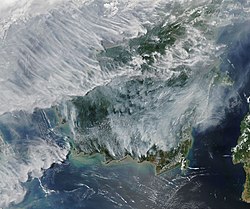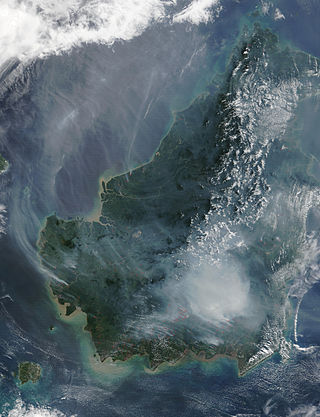
Peat swamp forests are tropical moist forests where waterlogged soil prevents dead leaves and wood from fully decomposing. Over time, this creates a thick layer of acidic peat. Large areas of these forests are being logged at high rates.
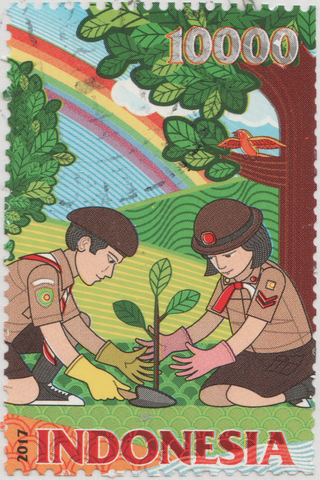
Environmental issues in Indonesia are associated with the country's high population density and rapid industrialisation, and they are often given a lower priority due to high poverty levels, and an under-resourced governance.

The Borneo peat swamp forests ecoregion, within the tropical and subtropical moist broadleaf forests biome, are on the island of Borneo, which is divided between Brunei, Indonesia and Malaysia.

The Bornean orangutan is a species of orangutan endemic to the island of Borneo. Together with the Sumatran orangutan and Tapanuli orangutan, it belongs to the only genus of great apes native to Asia. It is the largest of the three species of orangutans. Like the other great apes, orangutans are highly intelligent, displaying tool use and distinct cultural patterns in the wild. Orangutans share approximately 97% of their DNA with humans. Also called mias by the local population, the Bornean orangutan is a critically endangered species, with deforestation, palm oil plantations, and hunting posing a serious threat to its continued existence.

The wildlife of Malaysia is diverse, with Malaysia being a megadiverse country. Most of the country is covered in rainforest, which hosts a huge diversity of plant and animal species. There are approximately 361 mammal species, 694 bird species, 250 reptile species, and 150 frog species found in Malaysia. Its large marine territory also holds a great diversity of life, with the country's coastal waters comprising part of the Coral Triangle.

The Southeast Asian haze is a fire-related recurrent transboundary air pollution issue. Haze events, where air quality reaches hazardous levels due to high concentrations of airborne particulate matter from burning biomass, have caused adverse health, environmental and economic impacts in several countries in Southeast Asia. Caused primarily by slash-and-burn land clearing, the problem flares up every dry season to varying degrees and generally is worst between July and October and during El Niño events. Transboundary haze in Southeast Asia has been recorded since 1972 with the 1997 and 2015 events being particularly severe.

Betung Kerihun National Park is a national park located in the Indonesian province of West Kalimantan, on the island of Borneo. The park was established in 1995, and has a total area of 8,000 km2 (3,100 sq mi) or about 5.5 percent of West Kalimantan Province area. Together with the 2,000 km2 (800 sq mi) Lanjak Entimau Wildlife Sanctuary in Malaysia, it has been proposed to form a World Heritage Site named the "Transborder Rainforest Heritage of Borneo".

The Kahayan River, or Great Dayak River, is the second largest river after the Barito River in Central Kalimantan, a province of Indonesia in Kalimantan – the Indonesian part of the island of Borneo. With a total length of 658 km (409 mi) and with a drainage basin of 15,500 km2 (6,000 sq mi) in South Kalimantan, Indonesia. Mean annual discharge 1,178 m3/s (41,600 cu ft/s). The provincial capital Palangkaraya lies on the river. The main inhabitants are Dayaks, who practice slash-and-burn rice cultivation and pan for gold on the upper reaches. The lower Kayahan flows through a rich and unusual environment of peat swamp forests, which has been severely degraded by an unsuccessful program to convert a large part of the area into rice paddies, compounded by legal and illegal forestry.

The Mega Rice Project was initiated in 1996 in the southern sections of Kalimantan, the Indonesian section of Borneo. The goal was to turn one million hectares of unproductive and sparsely populated peat swamp forest into rice paddies in an effort to alleviate Indonesia's growing food shortage. The government made a large investment in constructing irrigation canals and removing trees. The project did not succeed, and was eventually abandoned after causing considerable damage to the environment.
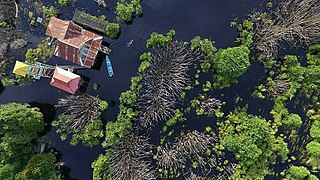
Sabangau National Park is a national park in Central Kalimantan, a province of Indonesia in Kalimantan, the Indonesian part of the island of Borneo established in 2004. Between 1980 and 1995 the site was a massive logging concessions area. After 1995, the park became a site for illegal logging, which resulted in up to 85 percent of the 568,700-hectare total park area being destroyed. By 2012, less than 1 percent of the park's total area has been reforested and at the current rate, it will take several centuries to restore it to its pre-logged state.

The Borneo Orangutan Survival (BOS) Foundation is an Indonesian non-profit non-governmental organization founded by Dr. Willie Smits in 1991 and dedicated to the conservation of the endangered Bornean orangutan and its habitat through the involvement of local people. It is audited by an external auditor company and operates under the formal agreement with the Indonesian Ministry of Forestry to conserve and rehabilitate orangutans. The BOS Foundation manages orangutan rescue, rehabilitation and re-introduction programmes in East and Central Kalimantan. With more than 400 orangutans in its care and employing more than 440 people at a 10 sites BOS Foundation is the biggest non-human primate conservation non-governmental organization worldwide. Nyaru Menteng and Samboja Lestari are the BOS Foundation sites that have received most extensive media coverage. Nyaru Menteng, founded by Lone Drøscher Nielsen, has been the subject of a number of TV series, including Orangutan Diary, Orangutan Island and the series Orangutan Jungle School, airing since 2018.

The Borneo lowland rain forests is an ecoregion, within the tropical and subtropical moist broadleaf forests biome, of the large island of Borneo in Southeast Asia. It supports approximately 15,000 plant species, 380 bird species and several mammal species. The Borneo lowland rain forests is diminishing due to logging, hunting and conversion to commercial land use.

The environment of Malaysia is the biotas and geologies that constitute the natural environment of Malaysia. Malaysia's ecology is megadiverse, with a biodiverse range of flora and fauna found in various ecoregions throughout the country. Tropical rainforests encompass between 59% and 70% of Malaysia's total land area, of which 11.6% is pristine. Malaysia has the world's fifth largest mangrove area, which totals over a half a million hectares.
Palm oil, produced from the oil palm, is a basic source of income for many farmers in South East Asia, Central and West Africa, and Central America. It is locally used as cooking oil, exported for use in much commercial food and personal care products and is converted into biofuel. It produces up to 10 times more oil per unit area than soybeans, rapeseed or sunflowers.

Deforestation in Indonesia involves the long-term loss of forests and foliage across much of the country; it has had massive environmental and social impacts. Indonesia is home to some of the most biologically diverse forests in the world and ranks third in number of species behind Brazil and the Democratic Republic of Congo.

Willie Smits is a trained forester, a microbiologist, conservationist, animal welfare activist, wilderness engineer and social entrepreneur. He has lived in Indonesia since 1985 and is an Indonesian citizen. He is married to Adrienne C. Watson since March 2016.
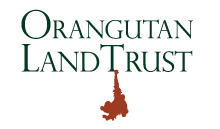
The Orangutan Land Trust is a UK charity with the objective of providing sustainable solutions for the long-term survival of the orangutan in the wild by ensuring safe areas of forest for their continued existence. The organization's president and co-founder, Lone Drøscher Nielsen, is a prominent wildlife conservationist.

Samboja Lestari is a Bornean orangutan rescue and rehabilitation centre, tropical rainforest restoration project, sun bear sanctuary, and eco-lodge located in the district of Samboja in Kutai Kartanegara Regency, East Kalimantan, Indonesia, owned and operated by the Borneo Orangutan Survival (BOS) Foundation. According to its founder, Willie Smits, Samboja Lestari uses the principles of People, Planet, Profit, attempting to provide incomes for local people using conservation. It is located about 38 kilometres from Balikpapan.

The Rimba Raya Biodiversity Reserve, nearly the size of Singapore, consists of 64,000 hectares of bio-diverse tropical peat swamp forest that contain as much as 1,000 plant and animal species per hectare and is one of the most highly endangered ecosystems on the planet. The project area and ongoing initiatives focus on environmental conservation, community outreach, and climate control. Rimba Raya is home to one of the few remaining relic populations of wild orangutans and is the largest privately funded orangutan reserve in the world. The area is also one of the world’s largest repositories of carbon. Rimba Raya is the world’s largest REDD+ project -Reduced Emissions from (Avoided) Deforestation and Degradation (REDD). The project developer, InfiniteEARTH, is an industry pioneer, delivering the world’s first REDD methodology in 2009.

There are three species of orangutan. The Bornean orangutan, the most common, can be found in Kalimantan, Indonesia and Sarawak and Sabah in Malaysia. The Sumatran orangutan and the Tapanuli orangutan are both only found in Sumatra, Indonesia. The conservation status of all three of these species is critically endangered, according to the International Union for Conservation of Nature (IUCN) Red List.





